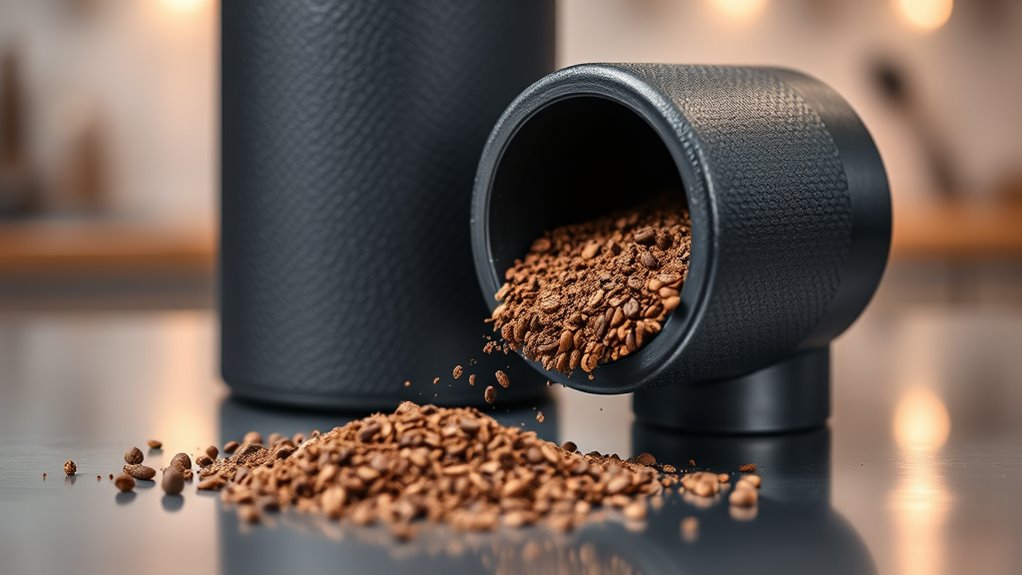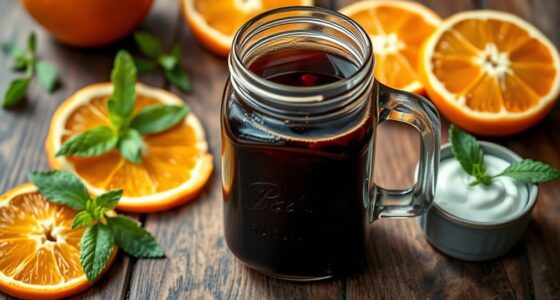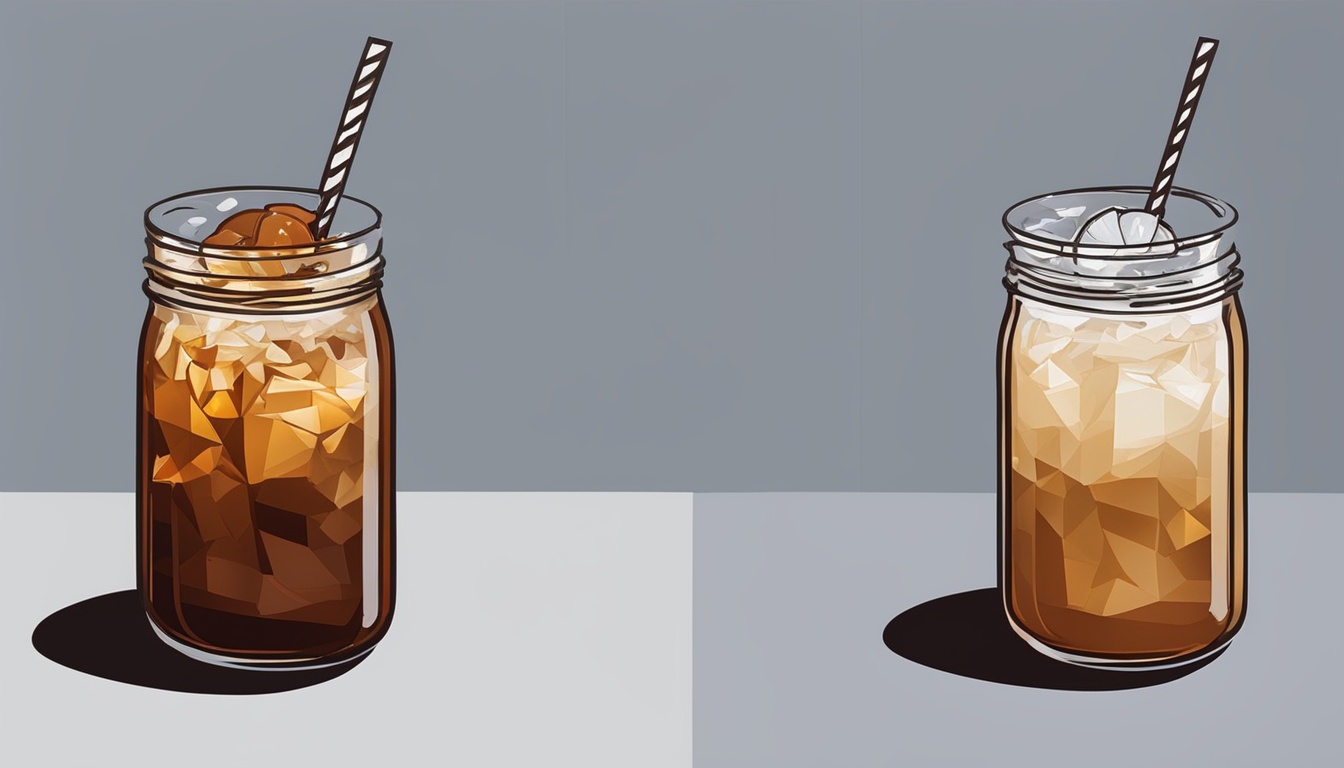Choosing the right grind size for cold brew is essential because it affects extraction, flavor, and brewing clarity. Ideally, you want a coarse grind, similar to sea salt, that allows water to flow evenly through the grounds. Too fine and it can clog filters or cause over-extraction, leading to bitterness. Too coarse, and you might end up with a weak brew. Want to discover how tweaking your grind size can improve your cold brew? Keep exploring.
Key Takeaways
- Use a coarse grind similar to sea salt to ensure even extraction and prevent filter clogging.
- Proper grind size balances extraction speed, flavor richness, and smoothness in the final cold brew.
- Finer grounds increase extraction and bitterness; coarser grounds promote a cleaner, lighter flavor.
- Consistent, uniform grind size from a burr grinder yields more predictable and balanced flavor profiles.
- Adjust grind size slightly based on steeping time and desired flavor outcome for optimal results.

Choosing the right grind size is essential for making smooth, flavorful cold brew. The grind size directly impacts how the water interacts with the coffee grounds during brewing, influencing both the extraction process and the final taste. When you select the proper grind, you’re setting the stage for ideal flavor extraction, which is what gives your cold brew its rich, well-balanced profile. If the grind is too coarse, the water will pass through too quickly, resulting in a weak, under-extracted brew with dull flavors. On the other hand, a grind that’s too fine can lead to over-extraction, making your cold brew bitter and overly strong.
Choosing the right grind size ensures balanced, flavorful cold brew with optimal extraction and smoothness.
Understanding brewing techniques is vital here because each method benefits from a specific grind size. Cold brew typically involves steeping coffee grounds in cold water for an extended period—usually 12 to 24 hours. This slow extraction process requires a grind that’s not too fine, as fine grounds can clog filters and make the brewing process messy or difficult. Aim for a grind similar to coarse sea salt; this size allows water to flow evenly through the grounds, promoting consistent flavor extraction. This way, you maximize the potential of your brewing technique, ensuring that you extract the full spectrum of flavors without introducing unwanted bitterness or weak notes.
Your goal is to find that sweet spot where the grind size facilitates proper contact between water and coffee grounds, allowing for efficient and even flavor extraction. If you notice your cold brew tastes flat or lacks complexity, consider adjusting the grind size slightly coarser or finer until you hit the right balance. Remember, the grind size influences the surface area of the coffee that’s exposed to water; a larger surface area speeds up extraction, so a finer grind isn’t always better in cold brew, which relies on slow, gentle extraction.
Pay attention to the texture of your ground coffee and how it interacts during brewing. Consistency in grind size is key—uneven grounds can lead to uneven flavor extraction, resulting in a brew that’s inconsistent from cup to cup. Invest in a good burr grinder if you can; it produces uniform grounds that help achieve more predictable results. Additionally, understanding filtration techniques can help prevent grounds from clogging filters and affecting flavor clarity. Ultimately, the right grind size isn’t just about following a rule—it’s about understanding how it affects brewing techniques and flavor extraction. Take the time to experiment with small adjustments, and you’ll find the perfect grind that yields a cold brew with depth, smoothness, and an irresistible aroma.
Frequently Asked Questions
Does Grind Size Affect Cold Brew Brewing Time?
Yes, grind size affects cold brew brewing time. When you use a coarser grind, it slows down the extraction rate, resulting in a longer brew time. Conversely, a finer grind speeds up extraction but can lead to over-extraction, making your cold brew bitter. Adjusting your grind size helps you control the brew time and optimize flavor. Keep experimenting to find the perfect balance for your desired strength and taste.
Is a Finer Grind Stronger or Weaker in Cold Brew?
A finer grind makes your cold brew stronger because it increases the extraction rate, similar to how a finely grated spice releases more flavor faster. With a finer grind, more surface area is exposed, pulling out flavors and caffeine more efficiently. So, if you want a bolder, more potent cold brew, opt for a finer grind, but watch out for over-extraction, which can lead to bitterness.
How Does Grind Size Impact Cold Brew Flavor Clarity?
Your grind size directly affects flavor extraction and visual clarity in cold brew. A finer grind increases surface area, leading to more intense flavor extraction, but can muddy the brew’s clarity. Conversely, a coarser grind yields a cleaner, more visually clear cold brew with subtler flavors. Adjusting the grind size helps you find the perfect balance between flavor richness and clarity, ensuring your cold brew meets your taste and aesthetic preferences.
Can I Use Regular Coffee Grind for Cold Brew?
You can use regular coffee grind for cold brew, but it’s like trying to paint with a broad brush when fine details matter. Your success hinges on good coffee bean selection and grind consistency. I once used a standard drip grind, and my cold brew lacked richness. For best results, opt for a coarser grind, ensuring uniformity, so your cold brew turns out smooth, flavorful, and perfectly balanced.
Does Grind Size Influence Cold Brew Shelf Life?
Yes, grind size influences cold brew shelf life because a finer grind increases surface area, leading to faster coffee oxidation. To maximize freshness, store your cold brew in an airtight storage container, which slows oxidation and preserves flavor. Using a consistent grind size helps prevent uneven extraction, further extending its shelf life. Proper storage and grind consistency guarantee your cold brew stays fresh and flavorful longer.
Conclusion
Remember, when it comes to cold brew, grind size truly makes a difference. A consistent, coarse grind helps you achieve the perfect balance of flavor and clarity. Don’t overlook this step—fine tuning your grind is like sharpening your tools; it improves the entire process. As the saying goes, “A chain is only as strong as its weakest link.” Keep experimenting and stay attentive to your grind size, and you’ll brew better cold brew every time.









